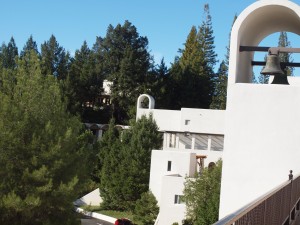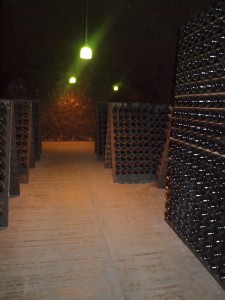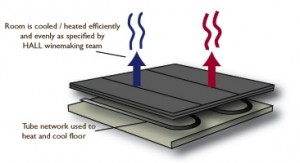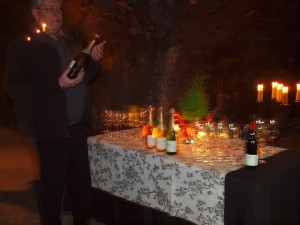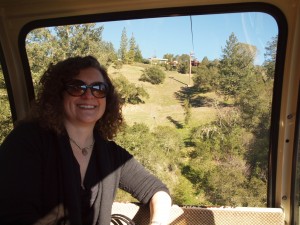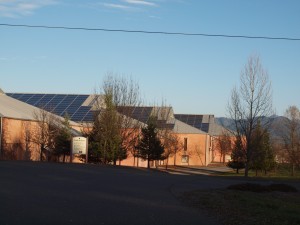Napa is one of my favorite places to visit. It has the perfect combination of great small town downtowns, historic spas, splendid landscapes, superb wine and architecturally significant wineries. So when one of my best friends declared that she wanted to celebrate her 40th birthday there the week before Christmas, I had no problem making that decision!! We were incredibly lucky to have five days of absolutely perfect weather (60-70 degrees with no rain) quiet wineries, and passable roads thanks to it being off-season. So I headed to Napa and Sonoma for fun and good wine, and it was a very pleasant surprise indeed to discover that “green” had landed solidly in wine country and sustainable practices were the norm.
Napa Green vineyard and land certification is a voluntary program for Napa Valley vintners and grape growers that enhances the watershed and restores habitat with sustainable agriculture practices. Currently, nearly 47,000 acres are enrolled in the program and nearly 19,000 acres are certified, with thousands more about to receive official certification. A majority (90%) of the Napa River watershed is in private ownership and public/private partnerships as well as programs like Napa Green are vital to their community.
Napa Green Certified Winery
The Napa Green Certified Winery continues the sustainable practices from the vineyard and land as demonstrated with Napa Green through the winemaking process in the wineries. Napa Green Certified Winery is an independent third party certification program to encourage and assist Napa Valley Vintners (NVV) and grape growers to implement beneficial and verifiable environmental practices through; preserving and enhancing the environment of the Napa Valley, demonstrating a commitment to our community, and providing leadership for the wine industry.
Napa Green Certified Winery is a Napa-specific set of sustainable and green business practices developed
forwineries. The NVV is working closely with their partners at the Napa County Department of Environmental Management and the Green Business Program as third party certifiers. Certified wineries demonstrate a commitment to conserving water and energy, reducing waste and preventing pollution. The efforts of Napa Green Certified Winery are aimed at reducing the carbon footprint of wine production facilities as part of the broader view of excellent business. Certification goes beyond compliance, meeting or exceeding environmental regulations related to winery operations and helps wineries become more sustainable through economically viable, environmentally sensitive and socially equitable practices.
Most of the wineries we visited (chosen for their good wine and/or great architecture) also happened to be participating wineries. Below is some information on a few of them and beautiful photos for all. If you’re thinking about a trip out west, I encourage you to spend a few days in Napa and Sonoma if you never have.
Cakebread, Chateau Montalena, Clos Pegase, Duckhorn, HALL, Hess Collection, Schramsberg, and Sterling are some of the wineries we visited that are participating Napa Green wineries. Each one is special as a winery and destination.
Cakebread Cellars is known for its chardonnays and its organic kitchen garden. Chateau Montalena is best known as the vineyard in “Bottle Shock” and the chardonnay that put Napa on the world vintner map. They are also known for their attention to healthy soils. Instead of chemical products, they use only sustainable, organic farming methods to promote the health of the soil and ultimately preserve the land’s productivity. For example, instead of using chemical pesticides, they combat destructive pests by growing cover crops and releasing ladybugs into the vineyard.
Clos Pegase was put on the map when Michael Graves designed the entire winery in Calistoga in 1987.It’s also known for the art sprinkled throughout the landscape, the designs of their wine bottles and labels and their splendid cabernet sauvignons. I never go to Napa without stopping here. This temple to wine and art produces all “estate bottled” wines, meaning that they grow all of their own grapes in their own vineyards and ensuring that their soil and process is as sustainable as possible is crucial to their winemaking.
Duckhorn has one of the most wonderful wine tasting experiences in Napa. I bought my most expensive bottle here, a Merlot actually, and saved that for the “love shack” at Pilot Knob Inn on New Year’s.
HALL Wines received (LEED) Gold Certification for their Napa Valley St. Helena winery, becoming the first
winery in California to be distinguished as a Gold certified facility by the U.S. Green Building Council’s LEED Green Building Rating System™. The HALL St. Helena LEED certified winery is one of most advanced wineries in California, with state-of-the-art facilities designed for ultra-premium wine production.
- Radiant Floors Allowing for Precision Winemaking and Maximum Energy Efficiency – Radiant flooring allows HALL to control the facility’s temperature while conserving energy. This technology, accomplished by running cold or warm water through the floor slab, provides a energy efficient and stable storage and production environment.
- Solar Energy – The sun provides more than 35 percent of the energy needed to power HALL St. Helena. Solar photovoltaic cells (solar panels) on the roof tops of the barrel cellar and fermentation building convert sunlight directly into electricity. Approximately 42,000 square feet of solar panels span the St. Helena winery roofs.
- Local Building Materials – More than 10 percent of materials used to build the facility were extracted, harvested or recovered, as well as manufactured, within 500 miles of the project site.
- Recycled Building Materials – More than 10 percent of the materials used were made with recycled content.
- Water Conservation– Drought tolerant plant species were selected for the winery landscaping which will reduce the demand for irrigation by more than 50 percent. In conjunction with this, all of the landscaping and vineyards are irrigated with recycled water. A 40-percent reduction of building water has also been achieved through the use of low-flow water outlets without compromising performance
The Hess Collection is known for its modern art museum more than for its wine. It was one of the earliest wineries to adopt sustainable practices. The winery opened in 1978 and over 600 acres were set aside as undeveloped land to support wild life corridors, fish friendly farming practices and bio- diversity. Every year they have increased their commitment to sustainability which can be read in detail on their website.
Shramsberg Vineyards are one of the oldest vineyards in
America, producing one of the premier sparking wines. This was my favorite visit by far this trip – the tour was a combination historic site tour and wine tasting, and for someone who typically is not a fan of “house tours”, this one exceeded most I have been on. Most of the tour was spent inside the limestone caves which are the oldest wine caves in the US and still used to ferment their special wines. The wine tasting was at the end of the tour and was a magical experience that can only be understood by looking at the photos!
Sterling is known for its Greek inspired winery and tram ride to the winery. But it is also known for its green efforts as one of the first 12 wineries to be certified as a Napa County Green Winery. Every year they recycle approximately 1,400 tons of waste, resulting in a waste diversion rate of 95%. This has resulted in awards in the Waste Reduction Awards Program from the California Integrated Waste Management Board for the past three years. (Proceeds from the award have been donated to local charities each year.)
In December 2008 their iconic tram was converted to solar power. The solar energy system produces more than 100,000 kilowatt-hours per year, which is equivalent to the energy required to power 5.5 homes for a full year. This conversion also eliminates 65 tons of CO2 emitted into the environment annually.
Clos du Bois, a Sonoma county winery, was particularly impressive and has been a champion of sustainability who is especially proud of their solar initiative, which utilizes over 4,000 solar panels to power their winery almost 100%, the equivalent of providing electricity to 164 homes a year. One acre of their almost 800 vineyard acres uses less water per year than a typical family of four.
A computer screen in the wine shop diagrams the power being used at any time on the winery and identifies where the power is coming from.
Other eco-friendly accomplishments at Clos du Bois
- Active participant in Sonoma Green Business Program since 2001
- Recipient of 2010 Save Energy Now award for “Energy Champion Plant”
- 2003 Fish Friendly Farming Outstanding Land Steward of the Year
- Restored fish and wildlife habitats and improved water quality
- 2002 Innovator Award from the California Dept. of Pesticide Regulation
- Reduced pesticide use in our vineyards with integrated pest management
- Encourage beneficial insects by planting cover crops
- Certified California Sustainable Winegrowing winery
And if you’d like to “subscribe” or follow this blog, True Green Cities, please sign up through the “Subscribe” button at the bottom left of this page. You’ll receive a daily recap when new blogs are posted.

